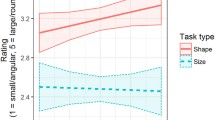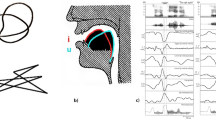Abstract
The question of the arbitrariness of language is among the oldest in cognitive sciences, and it relates to the nature of the associations between vocal sounds and their meaning. Growing evidence seems to support sound symbolism, claiming for a naturally constrained mapping of meaning into sounds. Most of such evidence, however, comes from studies based on the interpretation of pseudowords, and to date, there is little empirical evidence that sound symbolism can affect phonatory behavior. In the present study, we asked participants to utter the letter /a/ in response to visual stimuli varying in shape, luminance, and size, and we observed consistent sound symbolic effects on vocalizations. Utterances’ loudness was modulated by stimulus shape and luminance. Moreover, stimulus shape consistently modulated the frequency of the third formant (F3). This finding reveals an automatic mapping of specific visual attributes into phonological features of vocalizations. Furthermore, it suggests that sound-meaning associations are reciprocal, affecting active (production) as well as passive (comprehension) linguistic behavior.



Similar content being viewed by others
References
Ammon KH, Moerman C, Guleac JD (1977) Aphasics’ defective perception of connotative meaning of verbal items which have no denotative meaning. Cortex 13(4):453–457
Bond B, Stevens SS (1969) Cross-modality matching of brightness to loudness by 5-year-olds. Percept Psychoph 6:337–339
Bowman A, Azzalini A (1997) Applied smoothing techniques for data analysis: the kernel approach with S-Plus illustrations. Oxford University Press, USA
Bozzi P, Flores D’Arcais G (1967) Experimental research on the intermodal relationships between expressive qualities. Arch Psicol Neurol Psichiatr 28(5):377–420
Cohen J (1988) Statistical power analysis for the behavioral sciences. Erlbaum Associates, Hillsdale, NJ
Davis R (1961) The fitness of names to drawings: a cross-cultural study in Tanganyika. Br J Psychol 52:259–268
Farmer T, Christiansen M, Monaghan P (2006) Phonological typicality influences on-line sentence comprehension. Proc Nat Acad Sci 103(32):12203–12208
Gallace A, Spence C (2006) Multisensory synesthetic interactions in the speeded classification of visual size. Percept Psychophys 68(7):1191–1203
Gentilucci M (2003) Grasp observation influences speech production. Europ J Neurosci 17:179–184
Gentilucci M, Stefanini S, Roy A, Santunione P (2004) Action observation and speech production: study on children and adults. Neuropsychologia 42(11):1554–1567
Giard M, Peronnet F (1999) Auditory-visual integration during multimodal object recognition in humans: a behavioral and electrophysiological study. J Cogn Neurosci 11(5):473–490
Hockett C (1958) A course in modern linguistics. Collier-Macmillan, London
Holland M, Wertheimer M (1964) Some physiognomic aspects of naming, or Maluma and Takete revisited. Percept Mot Skills 19:111–117
Jespersen O (1922) The symbolic value of the vowel i. Philologica 1:1–19
Johnson RC, Suzuki NS, Olds WK (1964) Phonetic symbolism in an artificial language. J Abnorm Soc Psych 69(2):233–236
Köhler W (1929) Gestalt psychology. Liveright, NewYork
Kovic V, Plunkett K, Westermann G (2010) The shape of words in the brain. Cognition 114:19–28
Marks LE (1987) On cross-modal similarity: auditory-visual interactions in speeded discrimination. J Exp Psychol Hum Percept Perform 13:384–394
Marks LE (1989) On cross-modal similarity: the perceptual structure of pitch, loudness, and brightness. J Exp Psychol Hum Percept Perform 15:586–602
Marks L, Stevens J (1966) Individual brightness functions. Percep Psychophys 1:17–24
Maurer D, Pathman T, Mondloch C (2006) The shape of boubas: sound-shape correspondences in toddlers and adults. Develop Sci 9(3):316–322
Molholm S, Ritter W, Javitt D, Foxe J (2004) Multisensory visual-auditory object recognition in humans: a high-density electrical mapping study. Cereb Cortex 14(4):452–465
Newman S (1933) Further experiments in phonetic symbolism. Am J Psychol 45:53–75
Nuckolls J (2003) The case for sound symbolism. Ann Rev Anthropol 28:225–252
Nygaard L, Cook A, Namy L (2009) Sound to meaning correspondences facilitate word learning. Cognition 112(1):181–186
Parise C, Spence C (2008) Synesthetic congruency modulates the temporal ventriloquism effect. Neurosc Lett 442(3):257–261
Parise C, Spence C (2009) When birds of a feather flock together: synesthetic correspondences modulate audiovisual integration in non-synesthetes. PLoS ONE 4(5):e5664
Parise C, Spence C (under review) Audiovisual crossmodal correspondences and sound symbolism: an IAT study. Atten Percept Psychophys
Parise C, Spence C (submitted) Audiovisual cross modal correspondences. In: J Simner, E Hubbard (eds), The Oxford handbook of synesthesia. Oxford University Press, Oxford
Pulvermuller F, Fadiga L (2010) Active perception: sensorimotor circuits as a cortical basis for language. Nat Rev Neurosc 11:351–360
Rizzolatti G, Craighero L (2004) The mirror-neuron system. Ann Rev Neurosc 27:169–192
Root R, Ross S (1965) Further validation of subjective scales for loudness and brightness by means of cross-modality matching. Am J Psychol 78:285–289
Sapir E (1929) A study in phonetic symbolism. J Exp Psychol 12(3):225–239
Saussure F, Bally C, Sechehaye A, Riedlinger A, Baskin W (1966) Course in general linguistics. McGraw-Hill, New York
Shintel H, Nusbaum HC, Okrent A (2006) Analog acoustic expression in speech. J Mem Lang 55:167–177
Smith LB, Sera MD (1992) A developmental analysis of the polar structure of dimensions. Cognit Psychol 24:99–142
Stevens JC, Marks LE (1965) Cross-modality matching of brightness and loudness. Proc Nat Ac Scie USA 54:407–411
Waaramaa T, Alku P, Laukkanen AM (2006) The role of F3 in the vocal expression of emotions. Logop Phonatr Vocol 31(4):153–156
Walker P, Bremner GJ, Mason U, Spring J, Mattock K, Slater A, Johnson SP (2010) Preverbal infants’ sensitivity to synaesthetic cross-modality correspondences. Psychol Sci 21(1):21–25
Westbury C (2005) Implicit sound symbolism in lexical access: evidence from an interference task. Brain Lang 93(1):10–19
Acknowledgments
We would like to thank Elisa Pellencin for her precious help in running the experiments and extracting the phonological parameters of the vocalizations. This work was supported by a PRIN grant to F.P. and has been realized also thanks to the support from the Provincia autonoma di Trento and the Fondazione Cassa di Risparmio di Trento e Rovereto.
Author information
Authors and Affiliations
Corresponding author
Rights and permissions
About this article
Cite this article
Parise, C.V., Pavani, F. Evidence of sound symbolism in simple vocalizations. Exp Brain Res 214, 373–380 (2011). https://doi.org/10.1007/s00221-011-2836-3
Received:
Accepted:
Published:
Issue Date:
DOI: https://doi.org/10.1007/s00221-011-2836-3




